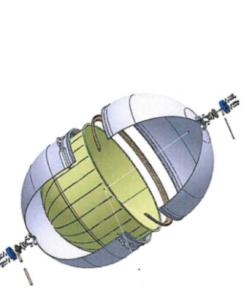Development, test and qualification of demisable propellant tanks
Programme
GSTP
Programme Reference
G61C-053MP
Prime Contractor
MT AEROSPACE AG
Start Date
End Date
Status
Closed
Country
Germany

Objectives
The objective of this activity is to develop, test and qualify demisable metallic propellant tanks for LEO satellites, aiming in particular at chemical monopropellant propulsion systems.
Description
Propellant tanks, due to their materials and the very high area to mass ratio that make them decelerate fast during reentry, are among the elements that survive reentry. In addition, tanks are normally quite enclosed within the satellite structure making them surviving the re-entry and having a large on-ground footprint. Therefore, the development of demisable tanks is considered of the highest priority by the LSIs for their uncontrolled re-entry LEO platftorms.
The LEO spacecraft carrying out uncontrolled re-entry at the End of Life (i.e. up to 1 to 2 tons, depending on the payload) are generally based on monopropellant systems in a blow down configuration, given the low Delta-V needed. Typical Maximum Expected Operating Pressures are in the order of 24 bar.
The preliminary activities indicate that the development of a monolithic tank on Aluminum alloys (e.g. AA2219) is a very interesting choice to improve the tanks? demisability. It also allows building upon the heritage from the development of other tanks, such as the on-going Vega-C tanks and the industrial experience regarding processes and manufacturing. Also, application of more advanced aluminium alloys such as AlLi are expected to have limited benefit and higher cost.
The use of Carbon Overwrapped pressurized Vessels (COPV) has also been investigated for monopropellant tanks. However, the demisability of composite materials is extremely complex and not yet fully understood. Tests show that depending on the resin and fiber properties, the overwrap can actually become a heat shield for the tank. Moreover, for monopropellant tanks only low internal pressure is required, and given the size of tanks targeted, the mass benefit of using a COPV is limited and the recurrent costs higher than a monolithic option. Therefore, this option is not considered for this phase.
During the CleanSat Concurrent Engineering Phase a set of harmonized requirements for propellant tanks designed for demise has been agreed among the European LSIs. The coordinated work between supplier and integrators is a key aspect of the CleanSat project, guaranteeing that the technology is developed in line with the needs of the end users.
Furthermore, a conceptual design and feasibility analysis was carried out showing that innovative design solutions result in a significant improvement on the demisability of these equipment imposing very limited constraints to the system.
The consolidated requirements establish a solid basis to support this development.
This activity will be implemented in a phased approach:
- Phase 1 (800 Keuro, duration14 months)
- Consolidate propellant tank design requirements, in line with requirements harmonized with the users.
- Detailed design of tanks shell and diaphragm. Analysis of the compliance with the interface, performance, thermo-mechanical and environmental requirements.
- Tests for sample characterization regarding long-term compatibility of shell material, diaphragm material, seal material and welding for process validation, with monopropellants, simulants and pressurant gasses.
- Demisability test at sample level and design analysis consolidation with state-of-the-art simulation tools.
- PDR.
- Phase 2 (1600 Keuro, duration 16 months)
- Engineering model design
- Manufacture full-scale EM, demonstrate manufacture processes
- Design verification by test, including: proof pressure, vibration testing at qualification level and leakage.
Application Domain
GEN-Generic Technologies
Technology Domain
19-Propulsion
Competence Domain
7-Propulsion, Space Transportation and Re-entry Vehicles
Keywords
32-Clean Space
Initial TRL
TRL 4
Target TRL
TRL 7
Achieved TRL
TRL 4
Public Document
Executive Summary
